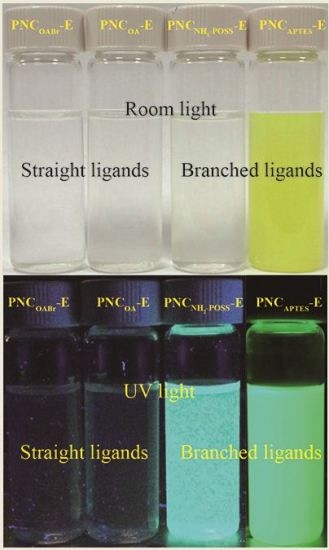Jun 14 2016
Perovskite materials have displayed immense promise for application in futuristic sensors, solar cells, LEDs, and other applications; however, their instability remains a serious limitation.
 Perovskite nanocrystals (PNCs) dispersed in ethanol under room light and ultraviolet light show better stability of PNCs capped with branching ligands compared to those capped with straight ligands. (Photos by Binbin Luo)
Perovskite nanocrystals (PNCs) dispersed in ethanol under room light and ultraviolet light show better stability of PNCs capped with branching ligands compared to those capped with straight ligands. (Photos by Binbin Luo)
A team of researchers at UC Santa Cruz (UCSC) tackled this issue by studying perovskite nanocrystals, where their instability is amplified by the large surface area of the particles corresponding to their volume. Atoms on the surface are susceptible to reactions that can deform the material, so molecules that attach to the surface - known as capping ligands or surface ligands - are utilized both to stabilize perovskite nanocrystals and to manage their properties.
The UCSC team has published their findings in Angewandte Chemie. They used distinctive branched ligands to synthesize perovskite nanocrystals in their experiments and established uniform particle size and better stability.
This new strategy to stabilize organometal-halide perovskites is an important step in the right direction. Our hope is that this could be used not only for perovskite nanocrystals but also for bulk materials and thin films used in applications such as photovoltaics.
Jin Zhang, Professor of Chemistry and Biochemistry, UCSC
Capping ligands
The team headed by Zhang analyzed the effects of various types of capping ligands on the stability of perovskite nanocrystals. Traditional perovskite nanocrystals capped with ligands comprising long straight-chain amines exhibited weak stability in solvents such as alcohol and water. Zhang's lab detected distinctive branched molecules that turned out to be highly more effective as capping ligands.
According to Zhang, the ligands’ branching structure safeguards the surface of the nanocrystals by taking up additional space than straight-chain molecules, thus creating a mechanical obstruction via an effect called as steric hindrance.
The branching molecules are more cone-shaped, which increases steric hindrance and makes it harder for the solvent to access the surface of the nanocrystals.
Jin Zhang, Professor of Chemistry and Biochemistry, UCSC
The team was able to manipulate the size of the nanocrystals by modifying the quantity of branched capping ligands applied during synthesis. They could attain uniform size in perovskite nanocrystals ranging from 2.5 to 100 nm, and providing a high photoluminescence quantum yield. It is a measure of fluorescence that is vital to the performance of perovskites in numerous applications.
Zhang's lab is studying the application of perovskite nanocrystals in sensors to identify specific chemicals. He is also collaborating with UCSC physicist Sue Carter on the application of perovskite thin films in photovoltaic cells for use in solar energy applications.
The first author of the paper on perovskite nanocrystals is Binbin Luo, a visiting researcher in Zhang's lab. Other coauthors include Ying-Chih Pu at the National University of Tainan, Taiwan; Sarah Lindley, Yi Yang, Liqiang Lu, and Yat Li at UCSC; and Xueming Li at Chongqing University, China.
This work was supported by NASA and the U.S. Department of Energy.